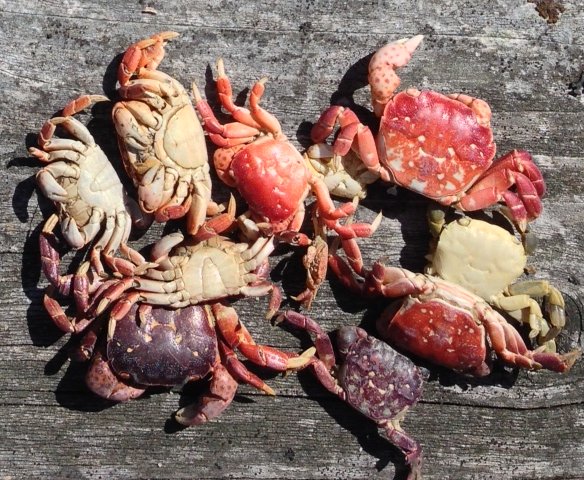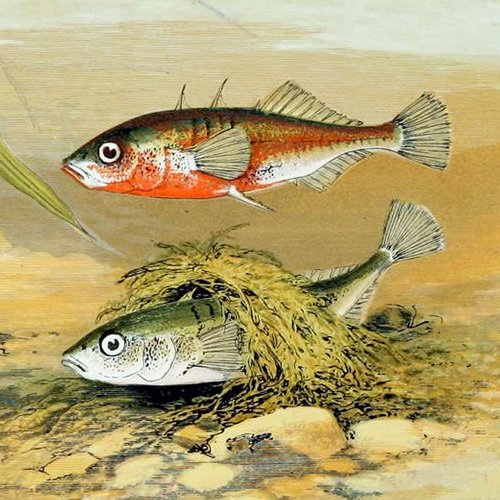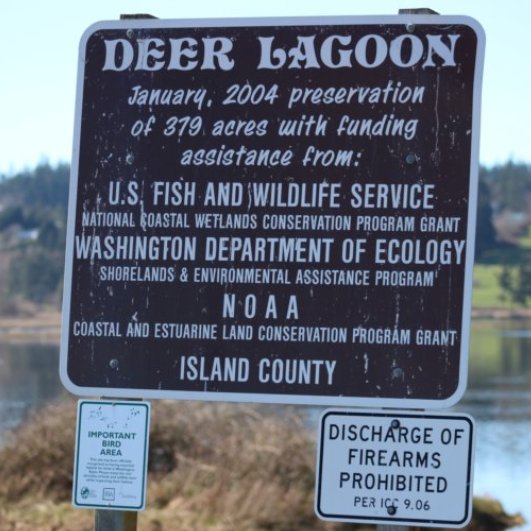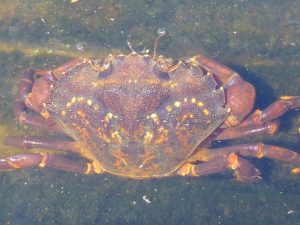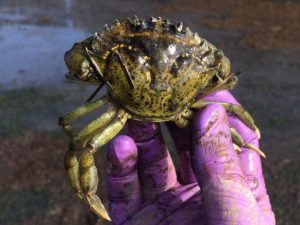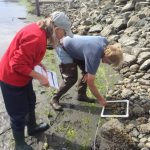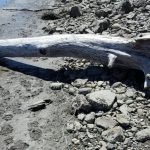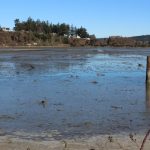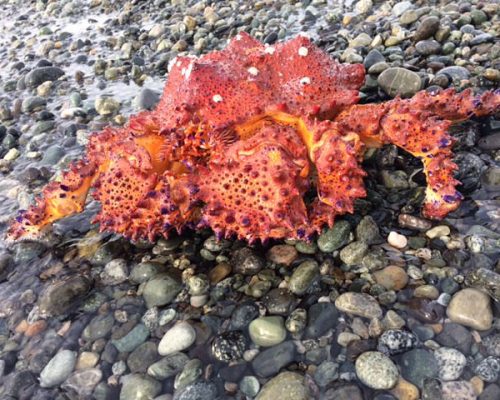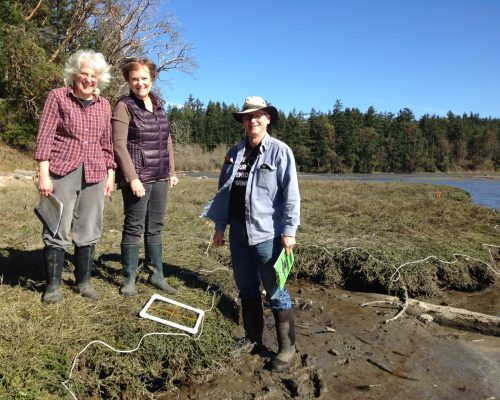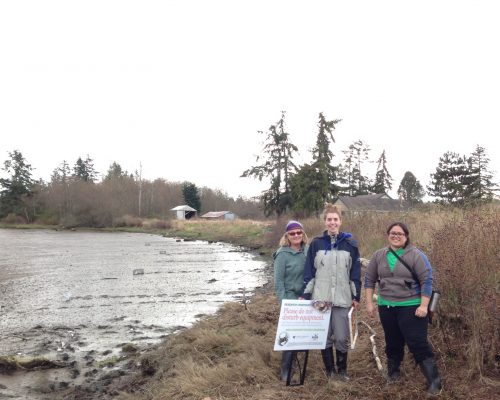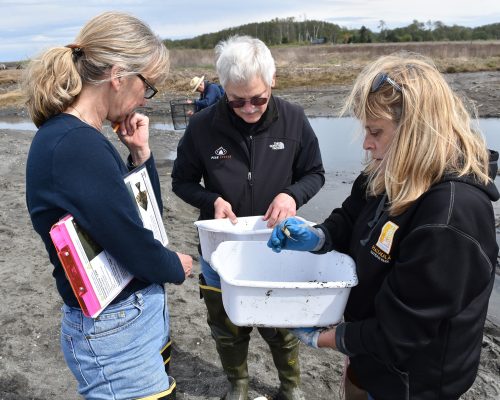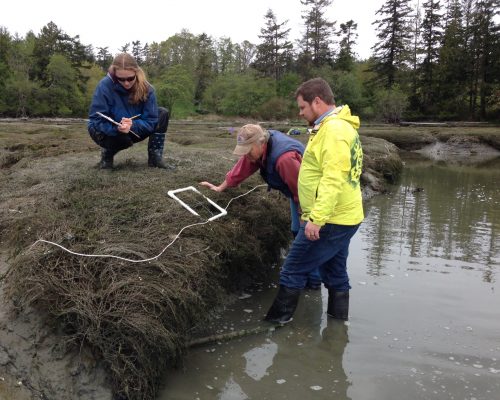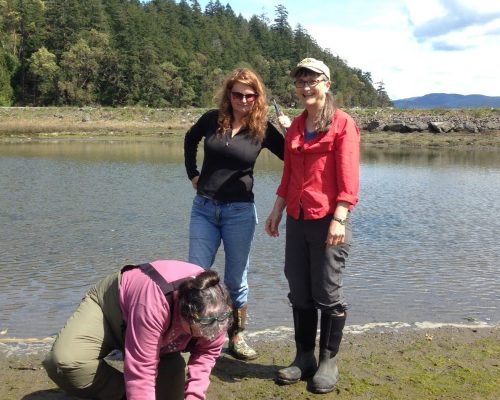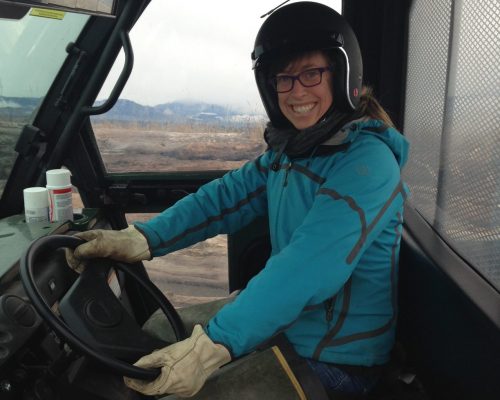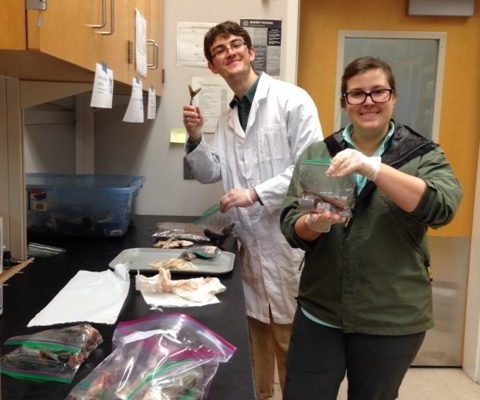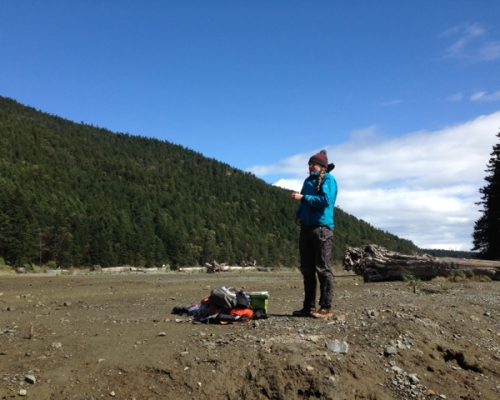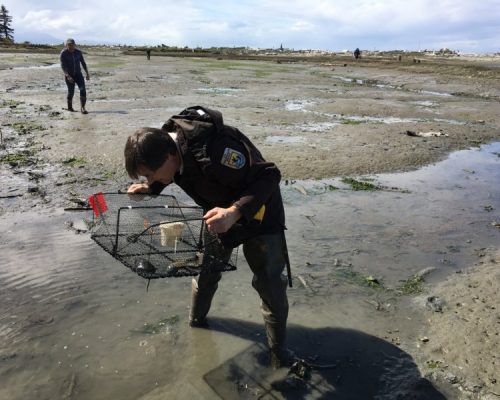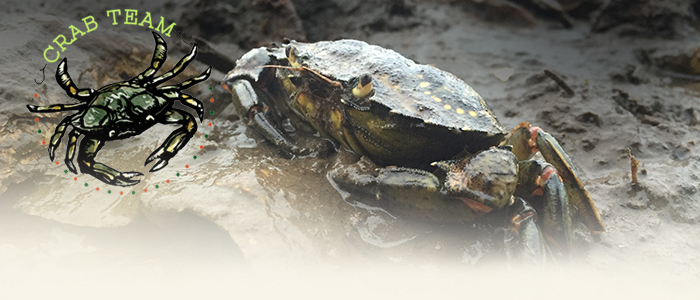
Crab Team Forges Ahead!
May 2nd, 2017
Traps are officially in the mud and 2017 sampling started with a bang. The captures of European green crab at Westcott Bay and Padilla Bay last year inspired tremendous support from many different stakeholder groups wanting to help protect shorelines. In addition to new citizen science volunteers, this year, Crab Team is developing and strengthening partnerships with agencies – like Washington’s Department of Natural Resources and US Fish and Wildlife Service (USFWS) – and tribes. Many of these groups are helping expand the scope of Crab Team monitoring by purchasing gear and training staff biologists to conduct Crab Team surveys. A huge thank you to the Skagit Marine Resources Committee which secured funding for gear for 16 additional sites. All told, we currently have more than 40 sites actively monitoring around Washington’s Salish Sea, with more to come!
The importance of the work Crab Team volunteers and partners do was almost immediately apparent this year, when USFWS captured green crab during their first month of sampling at a new Crab Team site at Dungeness Spit National Wildlife Refuge near Sequim. Agency staff and volunteers have been continuing to trap and remove green crab in the area, and Crab Team is working closely with USFWS and Washington Department of Fish and Wildlife to plan ongoing response efforts. You can read more about this sighting in our Press Room, or on our blog, check back for updates as the situation evolves.
In other news, we are excited to start sharing results from monitoring, which we have summarized in our 2016 Crab Team infographic. Volunteers collect data on all the organisms they observe, and our growing dataset is a treasure trove of ecological insight into pocket estuaries of the Salish Sea. We look forward to sharing more of what we learn from this dataset with you on our blog.
Keep your eyes on the beach, and your boots in the mud!
Crab Team
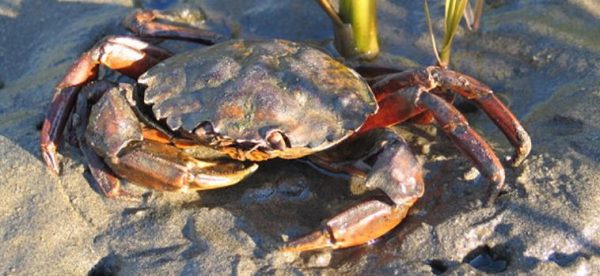
Photo: Sean McDonald.
“Green” Crab: Just How Green is “Green”?
If you have participated in any Crab Team training workshops, then you know full well that we don’t put much stock in color as a diagnostic characteristic for identifying crabs. Our ‘don’t use color’ mantra is repeated in our meetings and outreach materials – to the point of near obsession. Can you blame us though? When you look at as many crabs as we do, it doesn’t take long to see there are no hard, fast rules when it comes to color. We often see young ‘red’ rock crab with black and white stripes, ‘purple’ shore crab with an olive hue, and ‘yellow’ shore crab that would be more accurately described as violet. Indeed, color is variable in a wide variety of crabs native to the Pacific Northwest. But what about the invasive ones? Are European green crab really green? As it turns out, the answer is a resounding, “sometimes.”
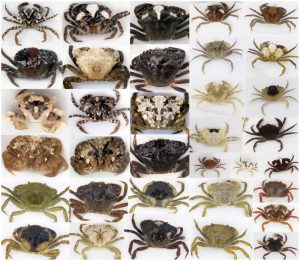
Juvenile European green crab come in a variety of colors and patterns of camouflage. The patterns are considered disruptive coloration, similar to zebras, and could be linked to their survival. Image from Stevens et al. 2014. Click to enlarge
As juveniles, green crab (let’s just call them Carcinus to avoid confusion) come in an array of colors and patterns. Tiny Carcinus — dime- to quarter-sized — can even change color, or at least brightness*, to match their surroundings. Juvenile crab achieve this feat by manipulating red, white, and black pigment cells, called chromatophores, beneath their thin shells. While not quite as dramatic as a chameleon (or octopus, to use a marine reference), these changes in color and brightness could mean the difference between life and death. Often times, camouflage is the only thing keeping a little crab from becoming a little snack for a hungry fish or bird, and there’s a distinct advantage to blending in with the seaweeds, shells, and cobbles that are common habitats for young crab in both their native and introduced range. (Read about how video games are used to learn about the effects of green crab patterns on survival.)
Adult green crab are not able to change color at will. Their thicker, heavily-armored shells are more opaque, which makes the chromatophores less visible. Nevertheless, adult green crab still range in color from green through yellow and orange to red. Color in adults results from pigment, astaxanthin, bound up within the shell itself and is linked to the duration of the intermolt period, which is the length of time between molts. Newly molted crab tend to appear bright green but individuals become redder the longer they go without molting. This process may be initiated by photo-denaturation of astaxanthin, which is known to turn red when degraded by light (Reid et al. 1997). By the way, this is the same reaction that occurs when a lobster is boiled!
Over the past half century, scientists have slowly unraveled the mystery of color change in Carcinus, and it turns out these differences are more than just skin, or rather shell, deep. There are distinct biochemical, physiological, and behavioral differences among color variants. Scientists interested in these differences tend to differentiate adult Carcinus into two categories: green morph and red morph.
Green morph Carcinus tend to be younger, smaller, and have thinner shells than their red counterparts. They’re also more tolerant of fluctuations in salinity, oxygen and temperature, and more resilient when exposed to pollutants. Conversely, red morph Carcinus are more aggressive and mate more successfully. These differences translate into substantial disparities in behavior and habitat preference in the field.
In the Atlantic, adult Carcinus occupy deeper water habitats than they do here, and exhibit daily patterns of activity. In particular, green morph Carcinus tend to forage with the tide and make intertidal migrations to shallow water. Older red morph Carcinus migrate less frequently or discontinue migrations altogether and remain in deeper water. Michel Kaiser and his colleagues suggested that “green morph” Carcinus might be forced to migrate in part to decrease aggressive encounters with larger red morph crab. (For more on this: McGaw and Naylor 1992; Reid et al. 1997, Wolf 1998…there’s even more, just ask us!).
Whether these ecological differences persist in populations along the West Coast remains to be seen. To date, there is little evidence of intertidal migrations and Carcinus, both green and red morphs, occur most often in shallow water.
For what it’s worth, the Carcinus captured in Westcott and Padilla bays in August and September of 2016 were all green morphs. These individuals were relatively small and likely only 1-2 years old. Time (and lots of monitoring!) will tell if there are more Carcinus in Puget Sound, but as we enter a new sampling season, it’s important for everyone to keep an eye out for the European green crab, which is only ‘sometimes’ green.
-P. Sean McDonald, Ph.D.
*We try to connect you with the research our information is based on. We apologize, however, that some articles require a subscription to access.
Species Name: Gasterosteus aculeatus
Size: Typically up to 1.5″ (4 cm), but can be up to 3″ (8 cm)
Distinguishing Features: “Cigar-shaped” fish with three dorsal spines and one pelvic spine. Defensive spines held erect when agitated. Color can be silver, to green and red.
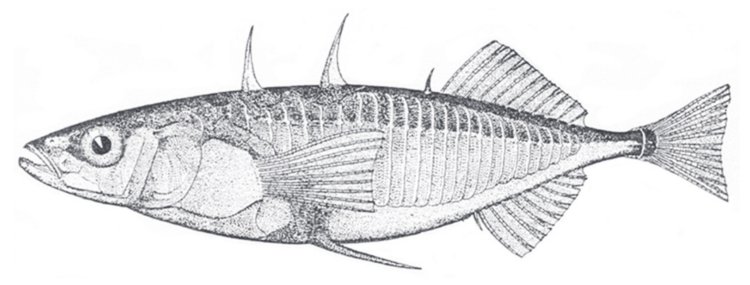
The Crab Team’s pokey pescado pequeño is one of our 10 most commonly trapped critters and the second most common fish, behind the ubiquitously trapped staghorn sculpin (see Summer 2016 Creature Feature). Three-spined stickleback live in cool and cold waters across the Northern hemisphere, with a very similar range to the potential range of European green crab. Their salinity tolerance is even broader than green crab; stickleback can live in coastal marine waters as well as rivers, streams and lakes that are entirely fresh. Stickleback migrate to mate, are fabulous dancers and are the recent darlings of evolutionary biology.
A trophy three-spined stickleback (Gasterosteus aculeatus or GAAC in Crab Team shorthand) would be a little bigger than an angler’s index finger (about 8 cm or 3 inches), but a typical adult is about half to two-thirds as big. Aptly named, this fish has three spines on its back, in front of the dorsal fin. To make it even more challenging to swallow whole, each pelvic fin is a large spine, and a small spine precedes the anal fin. When agitated, all its spines can be locked into an upright position, making them a potentially unpleasant meal.
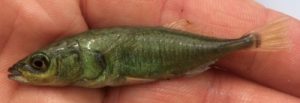
A laid back stickleback, with spines in relaxed position, found in Raab’s Lagoon. You can still see the vertical lines of the protective bony plates on its side between the pectoral fins and the tail.
Despite their hedgehog defense, stickleback can be important prey for some fish and many fish-eating birds. Watch gulls and herons long enough and you can appreciate birds’ knack for choking down uncooperative prey. Loons, terns, mergansers, kingfishers, ducks and even eagles have also been known to dine on stickleback, though not always successfully, as dead birds have been found with a stuck stickleback in their throat.
While many of us learn about anadromy (reproducing in freshwater, migrating to saltwater to grow) through the salmon lens, stickleback are among the many other species adapted to that lifestyle. However, their freshwater spawning is much more elaborate than a salmon. First, the male builds a bower-like nest. He then hangs out nearby, either fighting off anything without stickleback eggs in its belly or performing a zigzag dance for gravid (egg-bearing) females to entice them to enter his nest and lay eggs. Once a female has deposited eggs, the male fertilizes them, chases their mama away and protects and cares for the eggs until they hatch in a little over a week.
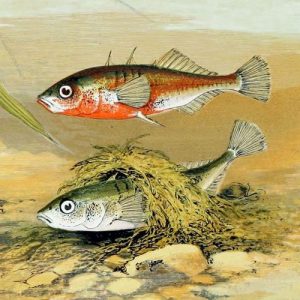
Three-spined stickleback in breeding coloration and an example of the elaborate nest the male constructs from sand and plant material. Artwork from Alexander Francis Lydon, British Freshwater Fishes.
As a side note… is it just a coincidence that the Crab Team code for three-spined stickleback (GAAC) is a homophone of “gack”, a sticky or messy substance, and that the male stickleback uses a sticky substance produced from its kidneys as glue to hold together his little domed love shack? Well, yes. It is a coincidence because Crab Team codes are based on the first two letters of the genus and species, and the sticky stickleback substance is called spiggin, from spigg, the Swedish name for the stickleback.
Like steelhead/rainbow trout or sockeye/kokanee salmon, some stickleback can be anadromous, while others remain in fresh water. For the latter, some even further differentiate by being open water predators of plankton and tiny fish, while others stay near the bottom, feeding on insects and small crustaceans. Stickleback that adopt different lifestyles might even avoid each other during the breeding season. Ultimately, reproductive isolation could potentially lead to the evolution of new, distinct species. Also, over a relatively shorter period of time, the freshwater stickleback tend to become physically different from their marine counterparts, having fewer or different sized spines, less armor plating and different colors. The variation in stickleback, and the repeated, rapid changes they show, have made them very popular subjects in evolutionary research, helping us to better understand the features of their genetic makeup and environment that facilitate these changes as natural selection works its magic.
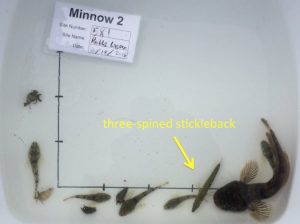
Three-spined stickleback in a minnow trap catch with staghorn sculpin, grainy-handed hermit crab, and a plainfin midshipman. Photo: Jeff Adams.
This flexible fish is already showing behavioral changes in response to climate change. Recent research in the UW School of Aquatic and Fishery Sciences showed that, in Alaska, the earlier break-up of ice covering lakes each year allows this fish to have multiple mating cycles in a single year. Because this fish is a dominant part of Alaskan lake ecosystem, this could have “ripple effects” in those places.
When one of these impressive little fish shows up in a Crab Team trap or should you just encounter it on your daily waterside wanderings, you can wish it well as it tries to avoid avian gullets, build the perfect nursery and dance like its future depends on it.

Crab Team was excited to scout Deer Lagoon, one of the first habitats we found that was a promising sampling site. Photo: Jeff Adams.
Nimble fingers are important tools on any Crab Team sampling crew, especially useful for outmaneuvering feisty shore crabs, but at sites like Deer Lagoon, they are essential. Wendy Visconty recounts the dilemma of how to best handle these deceptively strong pinchers: “Wow can those little crabby Hemigrapsus oregonensis and Hemigrapsus nudus bite! Some say – ‘Wear gloves to protect your hands!’ Some say ‘No, gloves just give them something to hang onto.’ What to do?”
On the north end of Useless Bay, on southern Whidbey Island, Deer Lagoon is among the top three Crab Team sites for the total number of critters captured in each trap. Unsurprisingly, the majority is hairy shore crabs (H. oregonensis, HEOR); an average trap (minnow or Fukui) from Deer Lagoon captures more than 125 of that species alone! Captain Tom Vos, who joined Crab Team in 2015 as part of a group of our anchor volunteers from Sound Water Stewards, says that division of labor and specialization can help the work go smoothly: “We have worked out a well-oiled machine when it comes to handling and counting the hundreds of crabs we pull in every time. Everyone seems to have a task in the process that they prefer and we huddle around the tubs in the mud…measuring, counting, recording, dumping….”
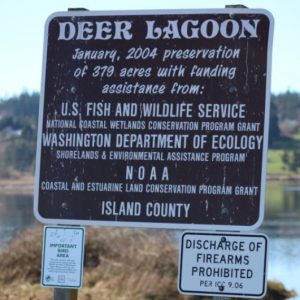
Deer Lagoon is a great site for birding as well as Crab Team sampling. If you don’t believe the words on the sign, the coating of bird droppings should convince you! Photo: Jeff Adams.
The size of Deer Lagoon, at roughly 85 acres, might offer part of the reason it’s such a great spot for pocket estuary critters, but at one time, it was much larger. The current extent of the lagoon is skirted by diking and rip rap revetments on the east and west. At low tide, nearly the entire lagoon becomes tideflat, with water remaining in only a few channels, all of which makes for extremely good shorebird foraging. The area offers one of the best birding spots on the island, with a dense assemblage of good habitats for feeding, nesting, and hiding. The birds are a draw for the Crab Team volunteers as well, who can sharpen their birding-by-ear skills while counting crabs: “Several of the team are also Audubon members and as we are hunched over our tubs/tasks, some bird would chirp, tweet, or whatever and without looking up they would say, ‘Oh, a Wilson’s Warbler’,” says Tom. The group also spotted some rare visitors this summer. In the words of Melissa Lebo, “While counting tiny crabs and searching for hair on legs or not, we were treated to a large number of white pelicans, unusual in this lagoon, and magnificent in their numbers. “
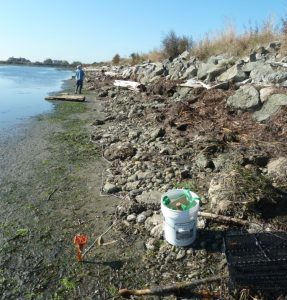
The riprap and cobble shoreline of Deer Lagoon provides more hard substrate than is typically found in muddy habitats, giving barnacles a place to attach. Photo: Tom Vos
Deer Lagoon is a habitat that is both dramatically altered and influenced by humans, and rich with wildlife, which makes it an excellent place to look for European green crab. Among the list of Crab Team sites, it is somewhat distinct in that the main upper-intertidal habitat is riprap rather than marsh vegetation. While green crab, similar to the abundant native hairy shore crab, burrow into muddy banks, they can also hide among stacks of boulders shoring up the dykes. The riprap and armoring at Deer Lagoon also offers a firm place to cling for many marine invertebrates, such as barnacles and limpets, which aren’t otherwise able to survive in low-energy, muddy places. That makes the habitat transect survey at Deer Lagoon a bit different, in that the substrate can be covered with animals rather than plants. In fact, Deer Lagoon was the site that first convinced us to track a category in these surveys to estimate how much space is taken up by these “live epifauna” (read why on our blog).
Many teams, depending on the site at which they sample, also find that another essential tool of the trade is at least one pair of hip waders. Even if the water isn’t very deep, the mud adds a few inches of sink, and sucks knee boots off easier than waders. Tom’s waders give him the ability to venture out from shore more comfortably than knee boots would, and make him de facto trap setter and retriever. Tom is also known on the team as ‘Mountain Goat Tom,’ for his skill at traversing rip rap. According to Melissa, “We were challenged by crawling down rip rap (except Tom, who glided down at full height). I landed one day in the mud as a result of a sunken boot, but no injury. There were surprise sinkholes at the edge of the rip rap. Tom utilized the bucket on every walk out to set the traps. We laughed at a potential rescue with all of us in the mud.” It never hurts to have a good sense of humor when facing the mud at a Crab Team site.
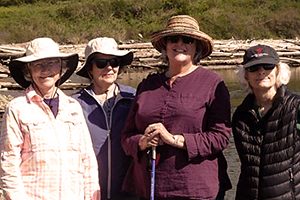
Deer Lagoon team on a sunny day. L-R: Wendy Visconty, Karen Brooks, Melissa Lebo, Sandy Shipley. Photo: Tom Vos
The crew at Deer Lagoon clearly enjoys spending time with each other in a beautiful spot. Says Wendy, “I was glad to generally need my sunscreen and sunglasses…. And I was grateful to be part of a dedicated and very fun group. I’m sure looking forward to beginning our surveys again in just a few months!” Sandy Shipley also joined to help learn about and protect local shorelines, “I hope as we gather evidence over time, whether we find green crabs or not, that this information will help scientists as they study environmental changes in our waters.” Indeed all of the data collected from sites like Deer Lagoon will help us gain a better understanding of pocket estuary communities in the Salish Sea, including how they might be impacted by human activity.
Photo Gallery
We love to get the virtual experience of monitoring with all of the Crab Team volunteers. Do you have a photo to share? Send it to crabteam@uw.edu. (Click on arrows to scroll, and photos to enlarge for more detail.)
